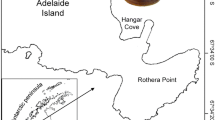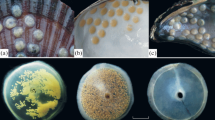Abstract
The reproductive biology of the Mediterranean vermetid gastropod Serpulorbis arenarius, a subtidal sessile solitary species that lives in shady rocky communities, was studied at two localities south-east of the Iberian Peninsula. Its population density is usually low, with specimens sometimes sparsely distributed. Its shell often appears to be covered by epibiotic organisms. The sex ratio is biased toward males (63%) in the populations of SE Spain, and the results point towards hermaphroditism with alternating sexuality. The results obtained suggest that all specimens are first males, change to females under some as yet unknown condition and, after the ovogenesis cycle has been completed, revert to the original sexual state (male). The possible adaptive forces that favour hermaphroditism in this species are discussed, and we hypothesise that the seizure of a spermatophore by males may stimulate sex change to female. Brooding females (51% of females studied) were found from March to December. In males, histological study of testes revealed that spermatogenesis seems to occur throughout the year. Females brooded between 5 and 28 (x̄=15) egg capsules, which were attached by stalks to the inner surface of the shell. It is noteworthy that the gonads of two of the specimens brooding egg capsules were developing testes. The newly laid egg capsules were filled with an organic intracapsular matrix, in which 40–153 (x̄=94) eggs were embedded. The mean diameter of the uncleaved ova was 352.5 µm. The organic intracapsular matrix and some nurse eggs were used as an extra-embryonic food source. Hatching occurred at an advanced veliger stage, immediately followed by metamorphosis. Therefore, the larval development of S. arenarius is of a lecithotrophic intracapsular type, with a short, free-swimming/crawling phase.




Similar content being viewed by others
References
Ankel WE (1936) Prosobranchia. In: Grinpe G, Wagler E (eds) Die Tierwelt der Nord- und Ostsee. Akademische Verlagsgesellschaft, Leipzig, pp 1–240
Barash A, Zenziper Z (1985) Structural and biological adaptations of Vermetidae (Gastropoda). Boll Malacol 21:145–176
Bieler R, Hadfield MG (1990) Reproductive biology of the sessile gastropod Vermicularia spirata (Cerithioidea: Turritellidae). J Molluscan Stud 56:205–219
Bieler R, Mikkelsen PM (1988) Anatomy and reproductive biology of two western Atlantic species of Vitrinellidae, with a case of protandrous hermaphroditism in Rissoacea. Nautilus 102:1–29
Boettger CR (1930) Studien zur Physiologie der Nahrungsaufnahme festgewachsener Schnecken. Die Ernährung der Wurmschnecke Vermetus. Biol Zentbl 50:581–598
Branch GM (1974) The ecology of Patella oculus from the Cape Peninsula, South Africa. Reproductive cycles. Trans R Soc South Africa 41:111–165
Breitburg DL (1985) Development of a subtidal epibenthic community: factors affecting species composition and the mechanisms of succession. Oecologia 65:173–184
Calvo M, Templado C (2004) Reproduction and development of the vermetid gastropod Vermetus triquetrus. Invertebr Biol 123:289–303
Calvo M, Templado J, Penchaszadeh P (1998) Reproductive biology of the gregarious Mediterranean vermetid gastropod Dendropoma petraeum. J Mar Biol Assoc UK 78:525–549
Carrick N (1980) Aspects of the biology of Gazameda gunni (Reeve, 1849), a viviparous mesogastropod and potential “indicator” of perturbation induced by sewage pollution. J Malacol Soc Aust 4:254–255
Charnov E, Bull JJ (1989) Non-Fisherian sex ratios with sex change and environmental sex determination. Nature 338:148−150
Chen MH, Soong K (2002) Estimation of age in the sex-changing, coral-inhabiting snail Coralliophila violacea from the growth striae on opercula and mark–recapture experiments. Mar Biol 140:337–342
Chen MH, Yang YW, Soong K (1998) Preliminary observations on change of sex by the coral inhabiting snail Coralliophila violacea (Lamark) (Gastropoda: Coralliophilidae). J Exp Mar Biol Ecol 230:207–212
Choquet M (1966) Biologie de Patella vulgata L. dans le Boulonnais. Cah Biol Mar 7:1–22
Collin R (1995) Sex, size, and position: a test of models predicting size at sex change in the protandrous gastropod Crepidula fornicata. Am Nat 146:815–831
Collin R (2000) Sex change, reproduction and development of Crepidula adunca and Crepidula lingulata (Gastropoda: Calyptraeidae). Veliger 43:24–33
Creese RG, Schiel DR, Kingsford MJ (1990) Sex change in a giant endemic limpet Patella kermadecensis, from the Kermedec Islands. Mar Biol 104:419–426
Fretter V, Graham A, Ponder WF, Lindberg DR (1998) Prosobranchia. Introduction. In: Beesley PL, Ross GJB, Wells A (eds) Mollusca, the southern synthesis, part B. Fauna of Australia, vol 5. CSIRO Publishing, Melbourne, pp 605–638
Ghiselin MT (1969) The evolution of hermaphroditism among animals. Q Rev Biol 44:189–208
Hadfield MG (1966) The reproductive biology of the Californian vermetid gastropods Serpulorbis squamigerus (Carpenter, 1857) and Petaloconchus montereyensis Dall, 1919. PhD dissertation, Standford University, Palo Alto, Calif., USA
Hadfield MG (1970) Observations on the anatomy and biology of two California Vermetid gastropods. Veliger 12:301–309
Hadfield MG, Hopper CN (1980) Ecological and evolutionary significance of pelagic spermatophores of vermetid gastropods. Mar Biol 57:315–325
Haszprunar G (1988) On the origin and evolution of major gastropod groups, with special reference to the Streptoneura. J Molluscan Stud 54:367–441
Healy JM (1988) Sperm morphology in Serpulorbis and Dendropoma and its relevance to the systematic position of the Vermetidae (Gastropoda). J Molluscan Stud 54:295–308
Heller J (1993) Hermaphroditism in molluscs. Biol J Linn Soc 48:19–42
Hoagland KE (1978) Protandry and evolution of environmentally mediated sex change: a study of the Mollusca. Malacologia 17:365–391
Hoagland KE (1984) Use of terms protandry, protogyny, and hermaphroditism in malacology. Am Malacol Bull 3:85–88
Hoagland KE (1986) Patterns of encapsulation and brooding in the Calyptraeidae (Prosobranchia: Mesogastropoda). Bull Am Malacol Union Inc 4:173–183
Houbrick RS (1990) Anatomy, reproductive biology and systematic position of Fossarus ambiguus (Linné) (Fossarinae: Planaxidae: Prosobranchia). Açoreana [Suppl]:October:59–73
Joose J, Geraerts PM (1983) The Molluscan. In: Saleuddin ASM, Wilbur KM (ed) The Mollusca physiology, vol 4. Academic, New York, pp 318–406
Kennedy JJ (1995) The courtship, pseudo-copulation behaviour and spermatophore of Turritella communis Risso, 1826 (Prosobranchia: Turritellidae). J Molluscan Stud 61:421–434
Laursen D (1953) The genus Ianthina: a monograph. Dana Rep 38:1–40
Lützen J (1972) Studies on parasitic gastropods from echinoderms. II. On Stilifer Broderip, with special reference to the structure of the sexual apparatus and the reproduction. Biol Skr 19:1–18
Mann T (1984) Spermatophores: development, structure, biochemical attributes and role in the transfer of spermatozoa. Zoophysiology, vol 15. Springer, Berlin New York Heidelberg
Melone G (1986) Sex changes in Opalia crenata (L.) (Gastropoda: Epitoniidae). In: Heppell D (ed) Abstr 9th Int Malacol Congr. National Museum of Scotland, Edinburgh, p 54
Miloslavich P, Penchaszadeh PE (1992) Reproductive biology of Vermetus sp. and Dendropoma corrodens (Orbigny, 1842): two vermetid gastropods from the southern Caribbean. Veliger 35:78–88
Morton JE (1951) The structure and adaptation of the New Zealand Vermetidae, part I. The genus Serpulorbis. Trans R Soc NZ 79:1–12
Morton JE (1965) Form and function in the evolution of the Vermetidae. Bull Br Mus (Nat Hist) Zool 11:585–630
Nelson BV (1982) The adaptive significance of aggregation and hermaphroditism in the sessile gastropod Serpulorbis imbricatus. Diss Abstr Int Sect B Phys Sci Technol 43:971
Nishiwaki S (1964) Phylogenetic study on the type of the dimorphic spermatozoa in Prosobranchia. Sci Rep Tokyo Kyoiku Daigaku Sect B 11:238–275
Nishiwaki S (1969) Seasonal size variations of the pallial slit in female Serpulorbis imbricatus (Prosobranchia, Vermetidae). Sci Rep Tokyo Kyoiku Daigaku Sect B 14:69–78
Nordsieck F, García-Talavera F (1979) Moluscos marinos de Canarias y Madeira (Gastropoda). Aula de Cultura de Tenerife, Tenerife
Osman RW (1987) Interactions between the vermetid Serpulorbis squamigerus (Carpenter) and several species of encrusting bryozoans. J Exp Mar Biol Ecol 111:267–284
Pasteur-Humbert C (1962) Les mollusques marins testacés du Maroc. Catalogue non critique. I. Les Gastéropodes. Trav Inst Sci Cherifien Fac Sci Rabat Sér Zool 23:1–245
Ponder WF (1994) The anatomy and relationships of three species of vitrinelliform gastropods (Caenogastropoda: Rissooidea) from Hong Kong. In: Morton B (ed) The malacofauna of Hong Kong and southern China. Hong Kong University Press, Hong Kong, pp 243–281
Ponder WF (1998) Superfamily Vanikoroidea. In: Beesley PL, Ross GJB, Wells A (eds) Mollusca, the southern synthesis, part B. Fauna of Australia, vol 5. CSIRO Publishing, Melbourne, pp 769–772
Reid DG (1986) Mainwaringia Nevill, 1885, a littorinid genus from Asiatic mangrove forests, and a case of protandrous hermaphroditism. J Molluscan Stud 52:225–242
Richter A, Luque AA (2004) Sex change in two Mediterranean species of Coralliophilidae (Mollusca: Gastropoda: Neogastropoda). J Mar Biol Assoc UK 84:1–10
Rivest BR (1983) Development and the influence of nurse egg allotment on hatching size in Searlesia dira (Reeve, 1846) (Prosobranchia: Buccinidae). J Exp Mar Biol Ecol 69:217–241
Scheuwimmer A (1979) Sperm transfer in the sessile gastropod Serpulorbis (Prosobranchia: Vermetidae). Mar Ecol Prog Ser 1:65–70
Scheuwimmer A, Nishiwaki S (1982) Comparative studies on three Japanese species of Serpulorbis (Prosobranchia: Vermetidae) with description of a new species. Venus 41:85–101
Schiaparelli S (1996) Contribution to the knowledge of Vermetidae (Mollusca: Gastropoda) from Ligurian Sea. Boll Malacol 31:267–276
Simone LRL (2001) Phylogenetic analyses of Cerithioidea (Mollusca, Caenogastropoda) based on comparative morphology. Arq Zool (Sao Paulo) 36:147–263
Soong K, Chen MH (2003) Sex expression of an immobile coral-inhabiting snail, Quoyula monodonta. Mar Biol 143:351–358
Spight T (1976) Hatching size and the distribution of nurse eggs among prosobranch embryos. Biol Bull (Woods Hole) 150:491–499
Templado J, Calvo M (ed) (2002) Flora y fauna de la Reserva Marina de las islas Columbretes. Secretaría General de Pesca Marítima, Ministerio de Agricultura, Pesca y Alimentación, Madrid
Tochimoto T (1967) Comparative histochemical study on the dimorphic spermatozoa of the Prosobranchia with special reference to polysaccharides. Sci Rep Tokyo Kyoiko Daigaku Sect B 13:75–109
Warén A (1980) Sexual strategies in Eulimidae (Prosobranchia). J Malacol Soc Aust 4:231
Warén A (1983) A generic revision of the family Eulimidae (Gastropoda: Prosobranchia). J Molluscan Stud [Suppl]13:1–96
Warén A, Bouchet P (1991) Mollusca Gastropoda: systematic position and revision of Haloceras Dall, 1889 (Caenogastropoda, Haloceratidae fam. nov.). In: Crosnier A, Bouchet P (eds) Résult Camp Musorstom, vol 7. Mem Mus Natl Hist Nat Ser A Zool 150:111–161
Warner RR (1988) Sex change and size-advantage model. Trends Ecol Evol 3:133–140
Warner RR, Fitch DL, Standish JD (1996) Social control of sex change in the shelf limpet, Crepidula norrisiarum: size-specific responses to local group composition. J Exp Mar Biol Ecol 204:155–167
Wright WG (1989) Intraspecific density mediates sex change in the territorial patellacean limpet Lottia gigantea. Mar Biol 100:353–364
Yonge C, Iles EJ (1939) On the mantle cavity, pedal gland and evolution of mucus feeding in Vermetidae. Ann Mag Nat Hist 3:536–555
Acknowledgements
We are much indebted to J. Bedoya (recently deceased) for his technical assistance with scanning electron microscopy at the MNCN, and to J. Fernandez for technical support. P. Penchaszadeh made helpful comments and suggestions in the early phases of the work. We are also indebted to A. Ritcher and S. Schiaparelli, who revised the final version, and G. Giribet, who corrected the English text and suggested improvements. The first author was sponsored by a postdoctoral grant from the Community of Madrid. This work has been partially funded by the projects REN2001-1965-C17-08/GLO and REN2000-0890/GLO of the Spanish Ministry of Science and Technology.
Author information
Authors and Affiliations
Corresponding author
Additional information
Communicated by O. Kinne, Oldendorf/Luhe
Rights and permissions
About this article
Cite this article
Calvo, M., Templado, J. Reproduction and sex reversal of the solitary vermetid gastropod Serpulorbis arenarius. Marine Biology 146, 963–973 (2005). https://doi.org/10.1007/s00227-004-1490-8
Received:
Accepted:
Published:
Issue Date:
DOI: https://doi.org/10.1007/s00227-004-1490-8




